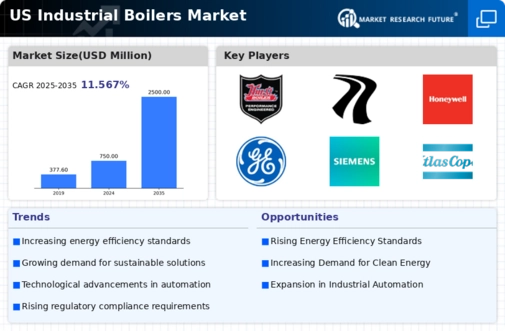Rising Energy Costs
The industrial boilers market is experiencing a notable impact from the rising energy costs in the United States. As energy prices continue to escalate, industries are compelled to seek more efficient boiler systems that can reduce operational expenses. This trend is particularly evident in sectors such as manufacturing and food processing, where energy consumption is substantial. The demand for high-efficiency boilers, which can operate at efficiency levels exceeding 90%, is likely to increase as companies aim to mitigate the financial burden of energy expenditures. Furthermore, the industrial boilers market is projected to grow as businesses invest in advanced technologies that enhance energy efficiency, thereby reducing overall costs and improving profitability.
Environmental Regulations
The industrial boilers market is significantly shaped by the stringent environmental regulations imposed by federal and state authorities in the United States. These regulations aim to reduce emissions and promote cleaner technologies, compelling industries to adopt more environmentally friendly boiler systems. For instance, the implementation of the Clean Air Act has led to the necessity for boilers to comply with specific emission standards, driving the demand for low-emission and high-efficiency boilers. As industries seek to align with these regulations, the market is likely to see an increase in the adoption of advanced technologies that minimize environmental impact, thereby fostering growth in the industrial boilers market.
Investment in Infrastructure
The industrial boilers market is poised for growth due to the ongoing investment in infrastructure across the United States. As the government and private sectors allocate funds for upgrading and expanding industrial facilities, the demand for reliable and efficient boiler systems is expected to rise. This investment is particularly evident in sectors such as energy, water treatment, and manufacturing, where modernized infrastructure necessitates advanced heating solutions. The industrial boilers market is likely to benefit from this trend, as companies seek to enhance their operational capabilities and ensure compliance with evolving industry standards. Consequently, the market may experience a robust increase in new installations and retrofitting of existing systems.
Focus on Process Optimization
The industrial boilers market is increasingly influenced by the focus on process optimization within various industries. Companies are recognizing the importance of integrating advanced boiler systems that not only enhance efficiency but also improve overall operational performance. This trend is particularly relevant in sectors such as petrochemicals and textiles, where precise temperature control and steam generation are critical. By adopting state-of-the-art boiler technologies, businesses can achieve significant reductions in energy consumption, potentially lowering costs by up to 20%. As industries strive for greater efficiency and productivity, the industrial boilers market is expected to witness a surge in demand for innovative solutions that facilitate process optimization.
Increased Industrial Production
The industrial boilers market is benefiting from the resurgence in industrial production across various sectors in the United States. As manufacturing activities ramp up, the demand for steam and hot water generation rises, driving the need for reliable boiler systems. According to recent data, the manufacturing sector has seen a growth rate of approximately 4% annually, which correlates with an increased requirement for industrial boilers. This growth is particularly pronounced in industries such as chemicals, pharmaceuticals, and food processing, where consistent and efficient heating solutions are essential. Consequently, the industrial boilers market is likely to expand as manufacturers invest in new boiler installations and upgrades to meet production demands.





















Leave a Comment